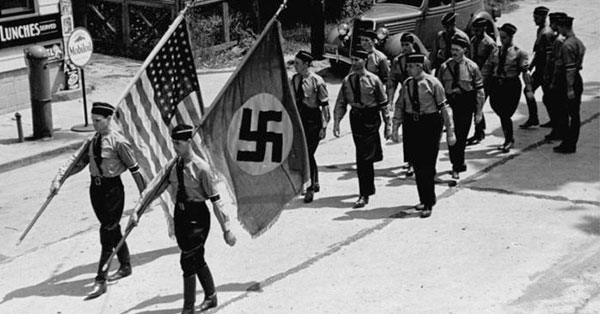While the world today recognizes Nazism for the evil that it is, things were not always so clear cut. In the heady days of the 1930s, economic turmoil caused by the Great Depression drove the radicalization of people around the world who were looking for someone to blame for their troubles. The United States was certainly not immune to this trend. Today most Americans know about the hate spread by groups like the Ku Klux Klan, but few recall the German-American Bund, an organization of American Nazis that hoped to emulate Hitler’s Reich in the United States.
Nazi associations began to crop up in the United States long before Hitler took power in Germany. In 1924 German expat Fritz Gissibl founded the “National Socialist Society of Teutonia” in Chicago, and quickly got to work filling its ranks with card-carrying members of the Nazi Party. As Gissibl’s organization branched out from Chicago it experimented with its branding, going through several different names including “Friends of the Hitler Movement” before settling on the more innocuous sounding “German-American Bund” in 1936. While membership in the German-American Bund was restricted to so-called “Aryans,” the Bund was quite interested in creating a community of like-minded people so long as they fit within these racial confines.

In order to fortify this growing following the organization constructed a network of camps across the United States from Wisconsin to New Jersey. These camps, though, were not the concentration camps associated with the darkest days of the Nazi regime. Instead, they were summer camps. The Bund established its flagship camp, Camp Siegfried, on Long Island outside of the sleepy town of Yaphank, some sixty miles east of New York City.
Camp Siegfried was supposed to be a haven for all German-Americans, both young and old, who had accepted Hitler’s message. Swastikas and the Nazi flag adorned buildings in the camp and the surrounding community, which featured avenues that bore names of prominent Nazi Party figures such as Joseph Goebbels and Hitler himself. For the youth, Camp Siegfried offered all of the typical trappings of a summer camp, including a lake, an archery range, and hiking trails.

Less typical were the lessons on eugenics and German language philosophy, or the parades in which children marched with both the American flag and the banner of the Nazi Party. For these ceremonial events marchers were outfitted in Hitler Youth uniforms that had been smuggled in from Germany by exchange students. The Bund even foot the bill to send a handful of campers to the 1936 Olympics in Berlin so that they could see the fatherland firsthand. While in Berlin Hitler granted the group’s chaperone, Bund leader Fritz Kuhn, a personal audience.
Across the lake from the youth camp adults came together to organize political activism, but many of them were more interested in the recreational prospects of Camp Siegfried than its politics. Shooting sports were particularly popular, so much so that the Bund briefly established an affiliation with the National Rifle Organization until the NRA learned of the Bund’s ideology and cut its ties. The big draw, though, was the beer.
Beyond being a major money maker for the Bund, the camp bar formed the center of social life, a place where Bundists could gather to enjoy a hefeweizen while extolling the virtues of the thousand-year Reich. Oktoberfest, of course, drew a consistent crowd. Those inclined to the well-known Nazi pastime of gardening could also participate in the camp’s commercial flower plantation, where one particularly enterprising Bundist produced a swastika-shaped shrubbery.

